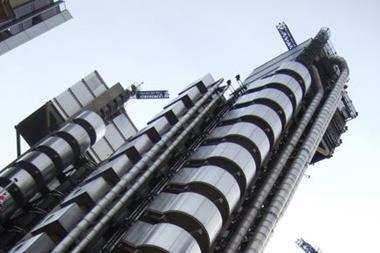Lloyd’s businesses may be below book value and look ripe for the picking, but private equity companies are finding it tough to raise money, while insurers have the cash but are cagey. Even intra-market deals are doubtful, but a benign hurricane season might tip the balance
Apollo Global Management’s apparent determination to buy a Lloyd’s insurer raises the question of whether other private equity firms – or industry suitors – are of the same mind.
Apollo has made three bids for Brit Insurance Holdings, the first two of which the insurer rejected. But Apollo’s third bid, for £10.75 a share, was enough to encourage Brit to allow the private equity firm access to its books for due diligence. Even if this latest development does not result in an acquisition, there is some indication that Apollo might seek to buy another Lloyd’s operation, such as Chaucer or Novae.
Lloyd’s is one of the key places for those interested in exposing their capital to (re)insurance risk. International groups including Tokio Marine, Validus and Flagstone Re have bought into the world’s oldest insurance market over the past three years. Validus closed its acquisition of Talbot Holdings in July 2007, Tokio Marine completed its acquisition of Kiln in March 2008, and Flagstone bought Marlborough in October 2008.
Lloyd’s, with its strict entry policy, is not the easiest or quickest place to set up an operation from scratch, but shares of listed Lloyd’s insurers are generally trading at discounts to their net asset values, making them more attractive to buyers.
Apollo is not the only private equity firm to have shown interest in Lloyd’s vehicles. Last year, Pamplona Capital Management built up a 9.99% stake in Chaucer, and was rumoured to be interested in increasing it further.
“You can see why a private equity company might take a look at a Lloyd’s business at the moment, because they might see hidden value there,” rating agency AM Best’s general manager, analytics, Miles Trotter says. “The share prices are depressed below net asset value. There is potential for a high-dividend yield, and you might see yourself as being well positioned for when the market turns around and rates improve.”
Barriers to deals
Furthermore, insurance and reinsurance companies, having replenished their balance sheets in 2009, have a surfeit of capital and little prospect of organic growth given the soft market in most business lines. Those without existing Lloyd’s operations might decide to rectify both situations with a purchase.
For many, however, Apollo’s quest for Brit is an anomaly. Although Lloyd’s businesses are trading at attractive discounts, making them look like bargains, many of Apollo’s private equity peers are finding it tough to raise capital, which is limiting their acquisition capabilities.
“The Apollo situation has caught everyone slightly off-guard because private equity firms are struggling to get the leverage they were historically able to access,” KBC Peel Hunt analyst Christian Stobbs says.
And while Lloyd’s insurers’ share prices are below book value, Brit’s spurning of Apollo’s first two advances shows they are prepared to hold out for a good price. “For the time being, Lloyd’s businesses remember having more buoyant share prices in recent history and don’t feel they are in a position where they have to accept a low offer,” Trotter says.
Collins Stewart analyst Ben Cohen agrees. “There are still a fair number of barriers to doing deals, not least general management’s desire to protect their position and boards’ view that the multiples on the screen are far too low,” he says . “There is a tension between what these businesses think they are worth, what they are fundamentally worth, and the multiples acquirers are willing to pay given the money they have.”
Danger of dissatisfaction
While private equity firms are cash-strapped, insurers and reinsurers are suffering the opposite problem: too much capital burning a hole in their pockets. At first glance, this may make them more likely acquirers than the private equity firms.
But some feel that even these cash-rich firms are unlikely to spur mergers and acquistions. If recent history is anything to go by, the most likely buyers of a Lloyd’s platform are young, expanding Bermudians as they seek to grow beyond US property business. In addition to Validus and Flagstone, fellow class-of-2005 reinsurer Ariel Re bought Atrium Underwriting in 2007. “The Bermudians that want a Lloyd’s platform have probably largely got one, so that rules them out a little,” Stobbs says.
Buying Lloyd’s insurers also comes with risks generally not found outside the market. One is that the success of many Lloyd’s businesses centres on an individual or a small group of people. “If you acquire a Lloyd’s entity, the danger is that there will be dissatisfaction among leading underwriters in the acquired entity. It is too easy for them to go to another Lloyd’s company and take business with them,” Trotter says.
It might be assumed that Lloyd’s businesses would be better merging among themselves. But some recent attempts at intra-market deals have been unsuccessful: Chaucer walked away from merger talks with Brit last June; only three months before, Novae pulled out of merger discussions with Chaucer.
Active underwriters and managing directors of Lloyd’s businesses often have strong personalities, which can make combining two firms tricky.
“There has been a lot of merger activity over the years but it has not always been an unbridled success,” says chairman of the Lloyd’s Market Association and executive director and chairman of Travelers Syndicate Management, Barnabas Hurst-Bannister. “Sometimes, cramming some high-profile personalities together doesn’t work terribly well.”
Urge to merge
The impetus to merge may increase, however, if there is a benign hurricane season in 2010. This would dampen hopes of hardening rates, pushing down valuations still further. If that happened, buying a Lloyd’s vehicle would be a “no-brainer”, according to Stobbs. “These companies largely make a 12%-15% return on equity. If you buy them at a discount to book value, the maths is very compelling,” he says.
Others feel it could be some time before a lack of catastrophes translates into mergers and acquisitions. “If there is a prolonged period of depressed rates, pressures will grow. But I don’t see that being the situation for the balance of the year,” Trotter says.
A further catalyst for mergers and acquisitions at Lloyd’s could be the European Commission’s Solvency II directive, which comes into force in January 2013. Many expect the additional capital and administrative burdens of the directive to hit smaller companies particularly hard, but firms operating at Lloyd’s could be insulated from its effects to an extent, as Lloyd’s itself is working to lighten the load for syndicates.
While acknowledging that Solvency II will cause an urge to merge among small and mid-sized insurers outside the market, Lloyd’s finance director Luke Savage expects little change to firms inside Lime Street. “We can help them with so much of the implementation burden, either by taking that on centrally or helping them manage it within their businesses,” he says.
Stobbs agrees: “I don’t think there is any danger that there will be any casualties of the Solvency II regime at Lloyd’s. Lloyd’s has thrown so much money and human resource at it that I don’t think that will be a catalyst for people putting the ‘for sale’ sign outside the front door.”
Any effect Solvency II has on Lloyd’s mergers is unlikely to be felt for some time. Trotter says: “There may be regulatory pressures on less diversified companies in Europe generally, and that could drive some specialist companies in Lloyd’s and elsewhere into the arms of larger parents.” IT






































No comments yet